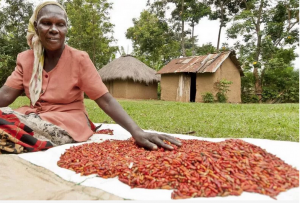Falls in the family of Solanaceae which includes tomato, egg plant, potato among others. Chili Pepper Farming originated from South America while some species from Mexico is largely now grown across the world both by small scale and large scale farmers for its nutritional, medicinal value and industrial use. China is believed to be the largest producing country of chili in the world which amounts to 45% of the total production.
CHILI PEPPER FARMING, NUTRITIONAL AND MEDICINAL VALUE
It is a source of nutrients and vitamins that help to reduce cholesterol levels in the body and assist in digestion. It also helps in fighting fungal infections and likely to reduce cancer which makes it a strong antioxidant. Finally is has industrial use. For value addition, chili sauce, powder, paste can be processed. There are many varieties, in sizes, tastes, spice levels and color all over the world.
HOW TO GROW CHILIES
- Chilies do well in hot, humid weather, prefers soil with good drainage and plenty of nutrients. Chili is both annual (replanted) and perennial (sprout). Grows from seeds or seedlings, (preferably in areas with long, warm growing seasons).
- Grows indoors (greenhouse) and outdoors (hot, sunny weather).
- Ensure good bed formation, proper drainage. 30cm spacing from drip to drip and 20cm from plant to plant is encouraged.
- Prepare nursery, mix fine compost with soil thoroughly.
- Wet the seeds then sow in soil, 3m to 4m deep.
- Keep soil moist by watering, which should be done in the morning to avoid root rot.
- Control pests e.g. cutworms aphids and thrips by drenching seed bed with insecticides.
- Apply fertilizer to maintain supply of essential nutrients. Crop protection and nutrition starts immediately after planting3 to 6 weeks apply folia fertilizers.
- Flowering, fruit formation start during the 6th week. Introduce potassium sulphate or nitrate to boost flowering as you keep the crop moist.
- Flower falls off after 7 to 10 days and is replaced by chili.
Make sure to water for the chili to grow bigger. Thereafter harvest chili from the 8th week
THE OPPORTUNITIES IN CHILI FARMING
Chili pepper farming is taking route in Kenya from a commercial point of view. The number of large scale farmers is increasing by the day with the demand of the produce also increasing both locally and internationally. Kenya is one of the medium to large suppliers of the produce to the EU market.
Mace Foods Ltd is one of those firms that have ventured into this market. And have come up with products for the same. A journey that started 19yrs ago in Germany after the founder attended a trade fare. The company has made sure that their products are always improved on (innovation and value addition) to make them better as per market demand.

The company is facing challenges which includes quality, consistency and availability of the product when they source the product from farmers. Indeed as a bulk buyer and exporter, this contributes to Mace Foods not meeting local and international demand. Based on this, the opportunity within the value chain is huge and farmers need to take advantage of this.

Mace Foods Ltd has also invested in human resource by employing the right people. Partnering with government agencies has helped with the formulation of their products. Lack of experts in food processes and lack of finances are some of the challenges the start – up went through.

The CEO and Founder, Margret Komen advocates for self – development and financial discipline as key to success in any business.
For more info and insights watch this on our Youtube channel. Remember to subscribe and leave a comment so that we can know how to improve. You can also share with your friends so that they can learn too.
You can also learn more about 63 Best potato varieties in Kenya 2022

Legumes and pulses
Thanks, we will highlight on that
Do you deal with farmers growing bullet chillies,I have a quarter at vegetative state In Laikipia county
No we dont deal with farmers growing chilies, we can connect you to the market through Mace foods
We have done beans kindly check here https://agriinnovationhub.com/blog/beans-farming/